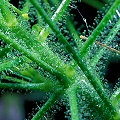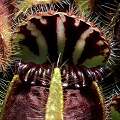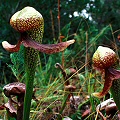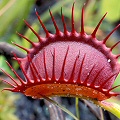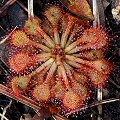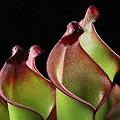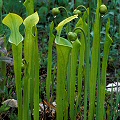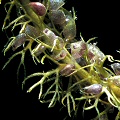| Byblis 'Cataby' |
Savage Garden:182 (1998)
Details |
CP Photofinder |
Cultivar: Byblis 'Cataby' D'Amato
Publication: Savage Garden:182 (1998)
Synonym: =Byblis gigantea Salisb.
Originator: A.Lowrie, from Cataby, W.A.
Nominant: A.Lowrie
Horicultural comment: name not registered with ICRA, description insufficient
Etymology: after the provenience of the plant
Description: Savage Garden:182 (1998)
"There are a few forms of this species (Byblis gigantea Salisb.). The typical one has fairly short stems with leaves clustered at the growing point. The more recently described Byblis ' Enneabba ' D'Amato and Byblis ' Cataby ' D'Amato forms have taller stems with leaves more sparsely arranged along them."
|
| Byblis 'Darwin Red' |
Savage Garden:183 (1998)
Details |
CP Photofinder |
Cultivar: Byblis 'Darwin Red' D'Amato
Publication: Savage Garden:183 (1998)
Synonym: =Byblis aquatica Lowrie & Conran
Originator: A.Lowrie, from Darwin, N.T.
Nominant: A.Lowrie
Horicultural comment: registration preliminary (standard missing)
Etymology: after the provenience and the colour of the plant
Description: Savage Garden:183 (1998)
"From the Darwin area (in the extreme north of the Northern Territory) are maroon plants called Byblis ' Darwin Red ' D'Amato."
|
| Byblis 'David' |
Carniv.Pl.Newslett.39:43 (2010)
Details |
CP Photofinder |
Cultivar: Byblis 'David' B.Barnes
Publication: Carniv.Pl.Newslett.39:43 (2010)
Synonym: =Byblis liniflora Salisb.
Originator: B.Barnes, Longwood, Fla., US, from "Rare Exotic Seeds", 12. 2. 2009
Nominant: B.Barnes
Registrant: B.Barnes, 7. 3. 2010
Horicultural comment: Registered 28. 7. 2010 {JS}
Standard: Carniv.Pl.Newslett.39:43 (2010)
Propagation: by seed and cuttings
Etymology: after size and shape of plant
Description: Carniv.Pl.Newslett.39:43 (2010)
"I soon discovered that the resulting plants possessed the same pulvinus anomaly that was first documented by Byblis ' Goliath ' B.Barnes in 2008. However, this marvelous cultivar is much smaller (to 20 cm tall) and forms pulvinus on the leaf axils as well as the pedicels. Interestingly, pulvinus formation is unconditional and the leaves move downward to form a tripod-like support for the plant. Another distinguishing factor is the existence of sessile glands on the shoot apex and leaves. Branching is rare but does occur.
Overall growing conditions have a great influence on the plant's flower structure. A comparison of sepal length to petal length unfortunately shows inconsistencies when compared to seedlings and clones in cultivation. The same inconsistencies exist when comparing filament to anther length. Anther coloration ranges from dark purple to light lavender, depending on the amount of sun received. Flower color ranges from light pink to dark purple. The back of the flowers range from white to tan or white with tan stripes in color. Striped and white flower forms are also known to exist. Equally important, overall growth habit and form is affected by lighting conditions, temperature differences, and moisture levels in cultivation. Therefore, one of the easiest ways to confirm that a plant is Byblis ' David ' B.Barnes is the existence of unconditional pulvini and sessile glands.
Another important defining feature is that Byblis ' David ' B.Barnes is self-pollinating and copious amounts of fertile seed are easily produced without any assistance, whereas Byblis ' Goliath ' B.Barnes requires two genetically distinct plants for successful pollination."
|
| Byblis 'Enneabba' |
Savage Garden:182 (1998)
Details |
CP Photofinder |
Cultivar: Byblis 'Enneabba' D'Amato
Publication: Savage Garden:182 (1998)
Synonym: =Byblis gigantea Lindl.
Originator: A.Lowrie, from Enneabba, W.A.
Nominant: A.Lowrie
Horicultural comment: name not registered with ICRA, description insufficient
Etymology: after the provenience of the plant
Description: Savage Garden:182 (1998)
"There are a few forms of this species (Byblis gigantea Salisb.). The typical one has fairly short stems with leaves clustered at the growing point. The more recently described Byblis ' Enneabba ' D'Amato and Byblis ' Cataby ' D'Amato forms have taller stems with leaves more sparsely arranged along them."
|
| Byblis 'Goliath' |
Carniv.Pl.Newslett.38:16 (2009)
Details |
CP Photofinder |
Cultivar: Byblis 'Goliath' B.Barnes
Publication: Carniv.Pl.Newslett.38:16 (2009)
Synonym: =Byblis filifolia Planch.
Originator: B.Barnes, Longwood, Fla., US, 2007
Nominant: B.Barnes, 9. 6. 2008
Registrant: B.Barnes, 13. 6. 2008
Horicultural comment: Registered 10. 5. 2009 {JS}
Standard: Carniv.Pl.Newslett.38:17 (2009)
Etymology: after size and shape of plant
Description: Carniv.Pl.Newslett.38:16 (2009)
"Plants can reach maturity in five months and produce flowers in showy masses. The flowers open at first light and promptly close by 4p.m.
To produce seed, the flowers must be cross pollinated. Flowers will not self pollinate, nor will pollen from different flowers on the same plant be successful. The flowers will last for about a week if not pollinated. Upon successful pollination, a flower takes on a slight bluish tint and then the petals drop off after three days. The petals are fused, even after petal drop.
What happens next truly makes this Byblis Salisb. variant unique.
On the third day, base of the pedicel changes character. It swells, elongates, and reflexes downward. It also becomes somewhat pale and transparent. The once-erect flower stalk is forced towards the ground as its ripening seed capsule develops.
The pedicel swelling is similar to structures on the base of legume stems, which are called pulvini (singular: pulvinus). Turgor pressure changes in the pulvinus of the "sensitive plant" (Mimosa pudica L.) is what causes that plant's leaves to droop when disturbed.
The entire process of changing direction from upright to furthest downward takes five to six days. I have determined that the pedicel appendages are geotropic. This was achieved by bending the top half of the plant over to an upside-down position immediately following pollination of several flowers. The pedicel appendages still formed and pointed down to the ground, regardless of its position. Seed capsules are slow to ripen and dehisce in four to five weeks.
I made another interesting discovery about these Byblis Salisb. plants in late October, 2008. The plants have a smell which reminds me of a sweaty, musty shirt that has been worn a few times without being washed. The smell is strongest near the center and the bottom of the plant, and the growth tip and flowers are completely odorless. What is more, the plants exhibit almost none of this smell until they are disturbed - a shaken plant changes from being only slightly smelly to quite pungent in only a few minutes! I think this smell may function to either repel herbivores or attract prey.
Another amazing thing about this variant is that it roots easily from cuttings, with an 80 to 90% success rate. The cuttings root in two to three weeks and exhibit the same traits as the parents. Live sphagnum works best as a rooting medium. When well rooted, the plants prefer to be moved into a half sand/half peat mix. They like a medium that is wet, but not over saturated. I use tall pots at least 13 cm (five inches) wide per plant, to accommodate the many long fibrous roots."
|

